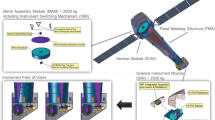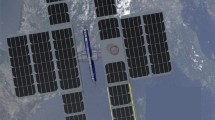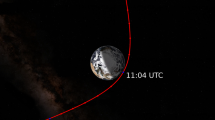Abstract
Euclid is a Medium-Class mission of the ESA Cosmic Vision 2015–2025 plan. Thales Alenia Space Italy has been selected as prime contractor for the Euclid design and implementation. The spacecraft will be launched in 2020 on a Soyuz launch vehicle from Kourou, to a large-amplitude orbit around the sun–earth libration point L2. The objective of Euclid is to understand the origin of the Universe’s accelerating expansion, by mapping large-scale structure over a cosmic time covering the last 10 billion years. The mission requires the ability to survey a large fraction of the extragalactic sky (i.e. portion of sky with latitude higher than 30 deg with respect to galactic plane) over its lifetime, with very high system stability (telescope, focal plane, spacecraft pointing) to minimize systematic effects. The AOCS is a key element to meet the scientific requirements. The AOCS design drivers are pointing performance and image quality (Relative Pointing Error over 700 s less than 25 m as, 68 % confidence level), and minimization of slew time between observation fields to meet the goal of completing the Wide Extragalactic Survey in 6 years. The first driver demands a Fine Guidance Sensor in the telescope focal plane for accurate attitude measurement and actuators with low noise and fine command resolution. The second driver requires high-torque actuators and an extended attitude control bandwidth. In the design, reaction wheels (RWL) and cold-gas micro-propulsion (MPS) are used in a synergetic and complementary way during different operational phases of the science mode. The RWL are used for performing the field slews, whereas during scientific observation they are stopped not to perturb the pointing by additional mechanical noise. The MPS is used for maintaining the reference attitude with high pointing accuracy during the scientific observation. This unconventional concept achieves the pointing performance with the shortest maneuver times, with significant mass savings with respect to the MPS-only solution.
















Similar content being viewed by others
References
ESA, Euclid System Requirements Document (SRD), Issue 1, 04 October 2013
ESA, Euclid Definition Study Report, ESA/SRE (2011) 12, September 2011
Lazzarin, M., Biolo, M., Bettella, A., Da Forno, R.: Euclid Mission: Theoretical Sloshing Model and CFD Comparison. AIAA-2012-4296, 48th AIAA/ASME/SAE/ASEE Joint Propulsion Conference, Atlanta, Georgia, 29 July–1 August (2012)
Lasker, B.M., Lattanzi, M.G., et al.: The second-generation guide star catalog: description and properties. Astrophys. J. 136(2), 735–766 (2008)
ESA, Euclid mission and payload definitions and associated methodology, EUCL-EST-TN-1-002, Issue 2, 10 December 2012
ESA, Guidelines for Optical Performance Requirements Evaluation, EUCL-EST-TN-1-006, Issue 1, 10 December 2012
Goodman, J.W. (Stanford University): Introduction to Fourier Optics, Second edition McGraw-Hill (1996)
ESA, ESA pointing error engineering handbook, ESSB-HB-E-003, Issue 1, 19 July 2011
Drosg, M.: Dealing with uncertainties, Springer
Author information
Authors and Affiliations
Corresponding author
Additional information
This paper is based on a presentation at the 9th International ESA Conference on Guidance, Navigation & Control Systems, 2–6 June 2014, Porto, Portugal.
Rights and permissions
About this article
Cite this article
Bacchetta, A., Saponara, M., Torasso, A. et al. The Euclid AOCS science mode design. CEAS Space J 7, 71–85 (2015). https://doi.org/10.1007/s12567-015-0084-2
Received:
Revised:
Accepted:
Published:
Issue Date:
DOI: https://doi.org/10.1007/s12567-015-0084-2




